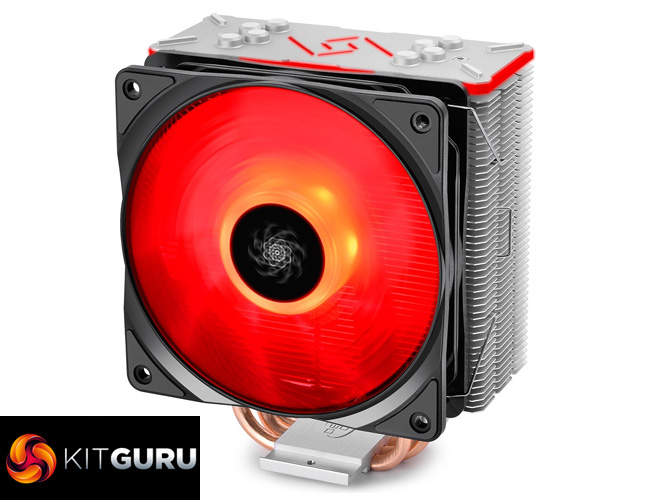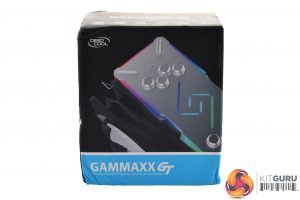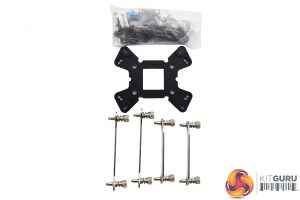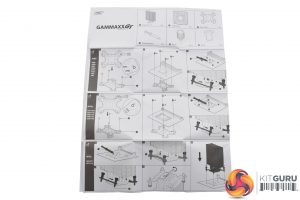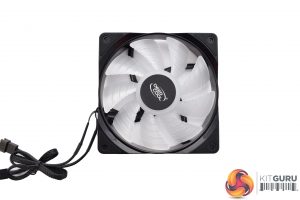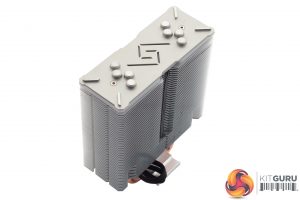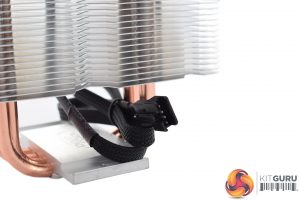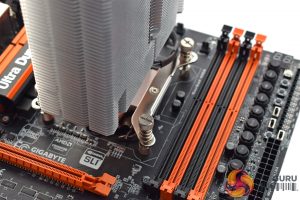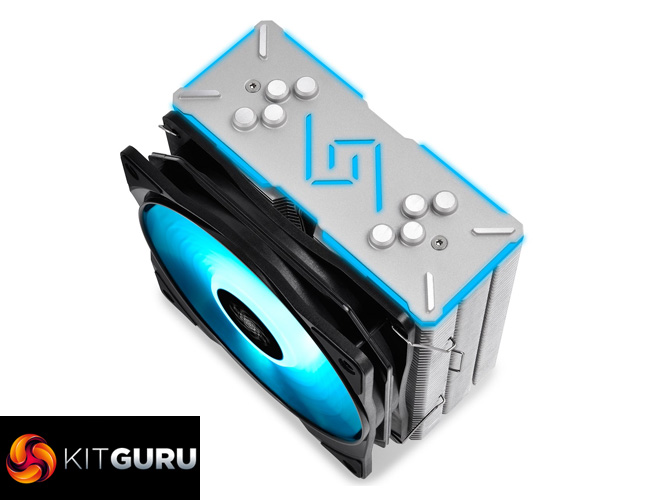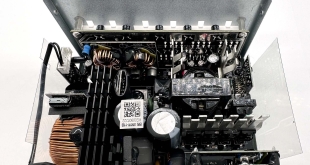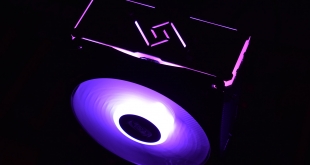
Slowly but surely, RGB lighting is making its way to the air cooling market. The Deepcool Gammaxx GT is the third RGB air cooler to have come through the doors at KitGuru labs, and at £50 it is also the cheapest. Can it do enough to stand out from the competition and make a case for itself?
One of the Deepcool Gammaxx GT‘s biggest rivals is the Cryorig H7 Quad Lumi – a cooler we mention not only due to its fantastic performance, but also because of its excellent implementation of RGB LEDs. The Gammaxx GT definitely has its work cut-out to dethrone the Quad Lumi as king of the RGB air coolers, but can it manage it? Let's find out.
Specification
- Overall Dimension: 135X84.8X156 mm
- Fan Dimension: 120X120X25 mm
- Net Weight: 870g
- Bearing Type: Hydro Bearing
- Rated Voltage: 12VDC
- Operating Voltage: 10.8~13.2VDC
- Started Voltage: 7VDC
- Rated Current: 0.23A
- Power Input: 2.76W
- Fan Speed: 500±150~1500±10%RPM
- Max. Air Flow: 56.5CFM
- Noise: 17.8~27dBA
The Deepcool Gammaxx GT ships in a colourful box that sports a large product photo on the front – and you can definitely tell this is a RGB air cooler.
Inside, all the necessary mounting hardware is provided, though there are no labelled bags which is a slight shame.
Moving on, the manual is quite brief, but very clear and easy to understand. Each socket has its own dedicated set of instructions which makes everything very simple and easy to follow, even if you are a first time system builder.
Elsewhere, the included 120mm fan is RGB capable, and accordingly has two cables – one standard 4-pin PWM cable and one 4-pin RGB connector.
Coming to the heatsink itself, on the face of it, it does not look like anything special – it uses 4 copper heatpipes and has the usual stack of aluminium fins, so in that sense it is like almost every other air cooler on the market.
However, you will notice a small logo – which I believe is meant to resemble a ‘G' – on the top of the heatsink, and this is where the RGB LEDs shine through. Accordingly, the heatsink does have a 4-pin RGB cable, and this can either be plugged into a small bundled controller, or directly into your motherboard (if it supports 4-pin RGB headers).Here I will walk you through the installation process. It is worth noting we test using a Z97 motherboard – socket LGA 1150. The process below reflects that.
The first thing to do is prepare the backplate – four screws should slot into the LGA 115x holes on the backplate. The screws themselves have a hexagonal base which fits right into the backplate, so the screws do not fall out when you turn the backplate over. This saves a lot of frustration when mounting the cooler, so it's definitely a thumbs up to Deepcool there.
Once the backplate is ready, slot it behind the motherboard socket area (as above).
Once the four screws are just peeping through the motherboard's socket holes, use the four nuts to lock the backplate in place.
After that, you can go ahead and screw the Intel mounting bracket to the heatsink – each bracket is secured with just a single screw.
With that done, the cooler can be mounted and secured to the four nuts and backplate.
Next, all that is left is to attach the fan using two clips. Job done!
The whole process is very simple and straightforward. I don't usually say this, either, but Deepcool's mounting hardware also feels like it is very good quality – the nuts and screws are very sturdy and weighty, and everything just has a quality feel about it.
Good job Deepcool.
Before moving on, we must look at the RGB lighting itself. Both the fan and the heatsink use RGB lighting, and all the LEDs synchronise together for a cohesive and slick look. Unfortunately, our test motherboard does not have a RGB header so I could not connect the Gammaxx GT that way, but Deepcool does provide a small controller which allows users to choose between static and colour cycle modes, set the brightness and set the colour cycle speed.
In my opinion, the lighting is excellent, and it is particularly good to see the Gammaxx GT comes with a RGB fan – this is something the H7 Quad Lumi missed and it really helps complete the overall ‘look' of the cooler.To test all CPU coolers, we devised an easily repeatable test with no variables other than the coolers themselves. This ensures that figures from every cooler we test are comparable with each other.
Test rig
Using an open-air test bench, we deploy an Intel Core i7-4790K plugged into a Gigabyte Z97X-SOC Force motherboard. Alongside this is 16GB of 2400MHz Corsair Vengeance DDR3, as well as a 120GB OCZ Trion 150 SSD. Powering everything is a Corsair RM750x PSU.
The test process
Testing coolers involves taking a total of 4 temperature readings per cooler. First, we measure the idle temperature of the i7-4790K at stock speeds (turbo boost disabled), before measuring its temperature under load at stock speeds. Next, we overclock the CPU to 4.5GHz using a 1.3 Vcore, ensuring greater heat output. In its overclocked state we then measure the idle and load temperatures of the CPU again. The figures we present are temperature deltas – meaning we take each temperature reading and minus the ambient temperature from it. This allows us to test in an environment that is not temperature-controlled.
To ward off potential comments or questions, we know 4.5GHz using a 1.3 Vcore is not the ‘best’ overclock – this particular CPU could reach that frequency at closer to 1.25 on the Vcore, which is more efficient. That is not the point, however. We are trying to stress the coolers to see how they deal with excess heat … hence the higher than necessary Vcore.
Where possible, each cooler’s fans are plugged directly into the motherboard using the CPU_Fan or CPU_Opt headers. Some AIOs, however, ship with their own fan controllers or PWM hubs. If we are unable to plug the fans directly into the motherboard, it is specified in the performance section of the review.
An idle reading comes from leaving Windows on the desktop for 15 minutes. A load reading comes from running Prime95’s (version 26.6) Small FFTs test for 15 minutes – enough time for temperatures to plateau.
Noise output
Unfortunately I am unable to accurately measure the sound output of CPU coolers using a digital sound meter. This is because I am based alongside a busy road (with high ambient noise levels). Using a sound meter is, as such, not possible as there are variables out of my control. However, I will try my best to subjectively describe the noise output in a helpful manner.Temperatures
All temperature charts are sorted with lowest load temperatures at the top.
In all honesty, the Gammaxx GT performs pretty much the same as other similarly-sized, 4-heatpipe air coolers. Across both tests, its performance figures are very close to the likes of the FSP Windale 4 and the Antec C400 and this makes sense, as they are essentially the same cooler.
The Gammaxx GT isn't quite in the same league as the H7 Quad Lumi – its main competitor – but it is cheaper, so there is definitely some element of compromise.
Acoustics
Noise levels are quite low, too, which definitely helps matters. Even when running an overclocked CPU under 100% Prime95 load, the RGB fan does not spin past 1500 rpm so it is far from intrusive. The fan is audible, yes, but put it in a case that is under your desk and it becomes very hard to complain about.The Gammaxx GT is a brand-new RGB air cooler from Deepcool, and it is certainly a very capable unit.
It is dead easy to install, so newbies will have no issues picking this up and getting going. The installation hardware also feels very good quality and that definitely helps the Gammaxx GT's appeal.
As for performance, the Gammaxx GT is pretty much as good as you would expect from a mid-sized air cooler that uses 4 heatpipes. It won't give the absolute lowest possible temperatures, but it should do the job on just about any mainstream processor, even when overclocked.
So, while it may be a competent, if unspectacular air cooler, the Gammaxx GT is all about the RGB lighting. Here, it does very well – both the heatsink and the fan come equipped with RGB LEDs, and the lighting can be controlled either via your motherboard's RGB header (if it has one), or via a small wired controller. The colours are vibrant and punchy, while the overall brightness is similarly impressive.
If I had to nitpick, I would say that the Cryorig H7 Quad Lumi's underglow LEDs do add something extra, while that cooler also offers software support via its internal USB connector – something which I feel does just elevate it above the Gamaxx GT.
Still, the Deepcool Gammaxx GT is a very effective RGB air cooler. It is easy to install, performs pretty well considering its size, and looks great. For £50, this is definitely a great deal for someone wanting RGB lighting in an air cooler.
You can buy one for £52.85 from CCL HERE.
Discuss on Facebook over HERE.
Pros
- Easy to install.
- Cools pretty well.
- Nice and quiet.
- RGB lighting looks great.
- Choice of bundled controller or motherboard control for RGB lighting.
Cons
- H7 Quad Lumi performs better.
- H7 Quad Lumi has underglow LEDs and offers software control without the need for a motherboard 4-pin RGB header.
KitGuru says: If you are looking for a decent RGB air cooler for less, the Gammaxx GT is an excellent option. The H7 Quad Lumi is slightly more sophisticated, but the Gammaxx GT still gets the job done very well indeed.
 KitGuru KitGuru.net – Tech News | Hardware News | Hardware Reviews | IOS | Mobile | Gaming | Graphics Cards
KitGuru KitGuru.net – Tech News | Hardware News | Hardware Reviews | IOS | Mobile | Gaming | Graphics Cards


